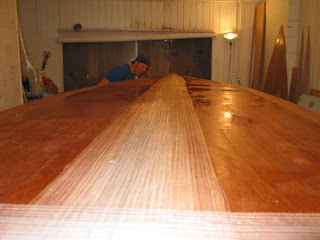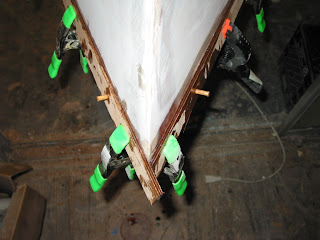The bottom glass is done!! This is a major hurdle in the build, and one that a lot of people worry about, but having helped with the glasswork on Frank's canoe, it seems it just takes time and attention to detail. The night before Cole and I laid out all the pieces of glass that we would use and trimmed them to size. Then we rolled them onto pieces of PVC for storage. For those of you doing this, first press the tape you use to secure the rolls onto the hull or something to cut down on its tackiness. Too sticky and you'll destroy the glass when you pull it off. This morning I put a layer of epoxy onto the hull. Cap'n Gnarly surveyed from the Crow's Nest.

I've mentioned before that this coat saturates the wood and prevents it from sucking later epoxy coats out of the glass. You have to make sure that the precoat starts to set up for this to work though and with the cold front, it took a couple hours to get tacky. I then called up the build crew so we could get going. Frank and Cole showed up with a quickness in their matching Jeep Cherokees. The Flatsstalker Army had arrived. It's hard to overstate how much help these guys were today. Pure gold.
Right off the bat, the epoxy started flying. Frank has to developed a pretty burly allergy to the West epoxy he used on his canoe and didn't want to risk reacting to the Silvertip, so he was the designated mixer for the day.

For those paying attention: yes, that is a pubic louse on his shirt and yes, the tag line does say, "Crabs, the butterflies of love". The French term for crabs is papillon de amor (or something close to that), and that's what it means. We just call them crotch crickets. Entomologist humor is a unusual at best. These are the people I work with everyday. Yeah, I know.
With epoxy all over our hands, we didn't get pictures of every stage of the glassing, but we snapped a few every hour or so. First, the chines, keel, and edges of the transom are laid up with biaxial tape. There are 3 layers on the keel, 1 on the chine and, two on the transom.

Where the tape is layered, the edges are offset to make fairing easier later. (Note: I have differed from the designer's recommended lamination schedule, with what should be a minor decrease in strength. I do not recommend doing this and if you choose to, do so at your own risk.)

With some discussion on the best techniques, we settled on:
- Frank mixed in a cup and poured into a disposable tupperware container that Cole was using.
- Cole slopped the epoxy onto the tape with a chip brush.
- After waiting to let the epoxy soak in I used a flexible spreader to move the epoxy around, force it into the glass, and make sure the fibers were oriented properly.
Here's the completely taped hull and Frank sampling the epoxy for some reason. It does smell kind of sweet I guess. Tragically, he died later that day. He always was a dumbass.

Gaining some confidence with the tape, we moved on to the sheet of bottom glass. This is the same material as the tape (12 oz. biax), but in a 50" wide section. We made something of a mess getting it straight on the sticky hull, but once on it laid out nice. We abandoned the brush with such a large area, and simply poured straight from the cup and used the spreaders to move the epoxy around. This glass soaks up a lot, so having a dedicated mix man is a huge time saver.

The roller in the foreground here was fantastic for getting air out of multiple layers of glass.

The area by the transom has a lot of overlapping layers of glass which makes it something of a bastard........

.......requiring the triple team.

Since Frank's mixing duties weren't full time, he was able to jump in and touch up areas that needed attention.
Before long we were finishing up at the bow. Once we finished every 6 feet or so, we would stop and put on a layer of 60" peel ply. I broke down and ordered some real peel ply and the stuff is awesome. It a polyester fabric. When pushed into the glass, excess epoxy bleeds through to its surface. It should eliminate most of the weave pattern in the final laminate, and help to keep the glass to epoxy ratio equal, making it stronger. What you're looking at in these pictures is the peel ply not the glass. When I pull the peel ply off tomorrow, the actual glass and epoxy should be pretty smooth with a matte finish ready to accept fairing compound. Let's just hope it comes off.


The actual glassing, from tape to peel ply, only took us five hours. That's killer. If I'd done it alone I could expect closer to 15. This would mean I would have to do tape and fabric separately. What we did today is termed working "wet on wet". This means that each layer, the precoat, each layer of tape, and the fabric, was wet when the next was applied. What this gives you is a chemical bond between each layer, essentially making the wood and up to 5 or 6 layers of glass in places one cohesive whole. Nice. It also makes fairing easier later. The alternative is sanding between each layer, basically making a mechanical bond between each layer. This brings the weak. The Flatsstalker Army made my boat stronger than I ever could have done on my own. This is why they rock the house and will always have a spot up on the bow whenever they want to catch some reds.
This is the first time in the build that I've been really pumped about how one of the building steps turned out, the first time I thought, "Man, we really kicked that one in the face." I couldn't be happier with the glasswork. I hope I still feel the same way when the peel ply comes off tomorrow. I'm tired. I'm going to bed... just as soon as I see if the epoxyis green enough to scrape out the runs.




 "Arrrgh. Your boat be crap me boy."
"Arrrgh. Your boat be crap me boy."
















































